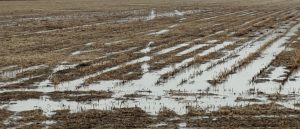Agronomy, Conservation, Homepage Slider, Water Quality
Precision U Meetings Focus on Reduced Working Days
By Dusty Sonnenberg, CCA, Ohio Field Leader: a project of the Ohio Soybean Council and soybean checkoff.
The Ohio State University College of Food, Agricultural and Environmental Sciences, Digital Ag Team is hosting Precision U virtually this year in a series of four meetings, all with a theme of Tackling Spring Operations with Reduced Working Days.
It is no surprise to Ohio farmers that the weather patterns have been changing, and the short- and long-term weather impacts create a need for adaptive management styles. “Since 1995 we have seen a decrease in the number of suitable working field days in Ohio from April through October,” said Aaron Wilson, Atmospheric Scientist at The Ohio State University and Byrd Polar and Climate Research Center.

Looking back at the 2020 mid-west growing season, defined as March through November, the growing season was warmer with both daily high temperatures and overnight lows above the 30-year average. When evaluating the weather over the long term, the daily highs and lows tend to average out. “This was Ohio’s 11th warmest March through November growing season,” said Wilson. “Last Winter was Ohio’s 5th warmest, going back to 1895. 2020 was also the 35th wettest growing season on average.”
When breaking down the growing season into shorter periods, there were definite differences. In the spring, which is considered March through May, and in the summer, which is June through August, the weather was different. “In the spring, in Central Ohio and points East, it was rather wet, but over the summer it turned hot and dry,” said Wilson. “In Darke County, one site received 20% of it’s annual precipitation in just five days.” There were several places in the state that saw 8-9 rain events makeup 40-50 percent of their total rainfall for the year. This impacts the number of days it is fit to perform field work.
History and a long-term perspective are important when considering the weather and climate. “2019 was the second warmest year since 1880 for the globe,” said Wilson. “2020 will likely take that spot after we finalize the numbers. We have had 9 out of the 10 warmest years for the globe all since 2005, and the five warmest years since 2015. If you were born after February of 1985, you have never experienced a cooler than normal month for the planet.”
“If we look at Ohio’s top ten winter through spring time periods, January through May, 8 of the top 10 warmest, and 5 of the top 10 wettest have occurred since 1990,” said Wilson. It is not just what happens in the spring, but also what happens in the winter and even the fall that leads to conditions that are challenging for our spring planting.”
“We know that our temperatures are getting warmer, but there are some key processes that are taking place, especially in the Midwest,” said Wilson. “As we increase the temperature and get warmer, we get more water vapor in the air. The water cycle of evaporating moisture, condensing into clouds, precipitation falling, and then running off the surface is actually intensifying. We have seen a high number of large precipitation events over the last 30 years than previously.”
The intensity is not just in the rainfall events, but also in the drought periods. “It is not just excess water, but we also have deficits of moisture during critical periods of the year as well,” said Wilson.
Looking back over the last 30 years, insights can be gained in how to manage and adapt to the changing weather. “Looking at the data from April through June, and the month of October, there are five fewer suitable working field days in the last 30 years, primarily in the months of April and October,” said Wilson. May has only seen a slight decrease in days with suitable field conditions, but June has seen an increase in the number of suitable days. This leads to the discussion about windows of opportunity to plant and do field work.”
“Looking at the future climate and moving into the mid-21st century, we are looking at temperatures 3-5 degrees warmer by 2050, and also looking at precipitation increases,” said Wilson. “These are seasonal changes in atmospheric circulation. Jet streams are changing so we get more rainfall in the fall, winter and spring, and decreasing trends to continue in the summer. We are intensifying the evaporation and water cycle. We have more off-season rainfall, making planting and harvest more difficult, and then a lack of rainfall during the growing season, which certainly presents a lot of challenges.”